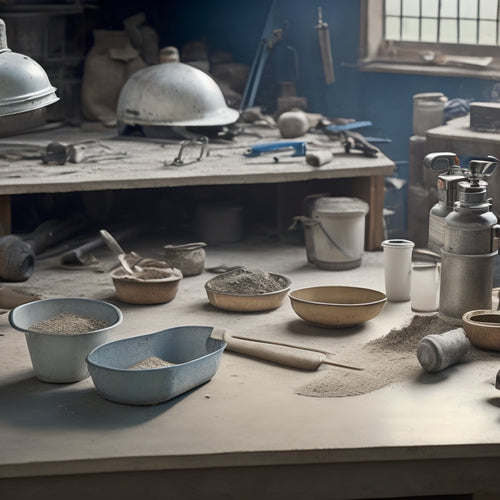
5 Best Tools for Cutting Concrete Successfully
Share
When tackling a concrete cutting project, you'll need the right tools to guarantee efficiency, safety, and precision. Consider rotary hammers, demolition saws, and reciprocating saws, each designed for specific tasks. Diamond blade saws are ideal for precise cuts, but choose the correct type based on your project's requirements. Additionally, prioritize safety with proper PPE, tool maintenance, and workspace organization. Mastering cutting techniques and selecting the right blade type will help you achieve smooth cuts consistently. By understanding the nuances of concrete cutting, you'll be well on your way to selecting the best tools for your project and releasing even more effective techniques ahead.
Key Takeaways
• Match the cutting tool to the concrete type, hardness, and desired cut quality to ensure efficient and precise cuts.
• Diamond blade saws are ideal for precise concrete cuts, and selecting the right blade type (turbo, segmented, or continuous rim) is crucial.
• Rotary hammers, demolition saws, and reciprocating saws are suitable for specific tasks, such as breaking, demolition, and curved cuts.
• Consider embedded materials like rebar, which can impact cutting efficiency, and choose a tool that can handle these obstacles.
• Regularly inspect and maintain cutting tools to prevent damage, ensure safety, and achieve consistent results.
Selecting the Right Cutting Tool
When cutting concrete, you need to choose a tool that matches the specific requirements of your project, taking into account factors such as the type of concrete, its hardness, and the desired cut quality. This decision is vital, as using the wrong tool can lead to inefficient cutting, damage to the tool or concrete, and even safety hazards.
You'll want to reflect on the various tool types available, including rotary hammers, demolition saws, and reciprocating saws, each suited for specific tasks and concrete types.
Material considerations are also essential when selecting a cutting tool. For instance, if you're working with high-strength concrete, you'll need a tool that can handle the increased hardness. You may also need to evaluate the presence of rebar or other embedded materials that can affect the cutting process.
Diamond Blade Saw Essentials
You'll likely find yourself reaching for a diamond blade saw when you need to make precise cuts in concrete, as these tools have proven themselves to be highly effective in a wide range of applications.
When selecting a diamond blade, you'll need to take into account the type of cut you want to make and the type of concrete you're working with. There are several diamond blade types to choose from, including turbo, segmented, and continuous rim blades, each suited for specific tasks.
Proper blade maintenance is essential to extend the life of your diamond blade saw and guarantee peak performance. Regularly cleaning the blade and saw will prevent concrete dust and debris from accumulating and affecting the cutting process.
You should also inspect the blade for signs of wear, such as cracks or excessive wear on the diamonds, and replace it when necessary. Additionally, following the manufacturer's guidelines for blade rotation and cutting speed will help prevent overheating and premature wear.
Cutting Concrete With Precision
Precision in cutting concrete requires a deep understanding of the material's properties and the cutting tool's capabilities, allowing you to make accurate calculations and adjustments on the fly.
When you're working with concrete, you need to take into account factors like its thickness, aggregate size, and moisture content to determine the best cutting techniques for the job. For instance, thicker concrete may require a more aggressive cutting approach, while thinner slabs might benefit from a more precise, controlled cut.
To achieve precision, you'll want to select the right cutting tool for the task at hand. Diamond blades, for example, are ideal for making clean, accurate cuts in concrete. By choosing the correct blade type and adjusting your cutting speed and pressure accordingly, you can minimize errors and maximize efficiency.
Additionally, understanding the ideal cutting techniques for your specific tool will help you achieve precise, professional-looking results. With practice and patience, you'll be able to tackle even the most complex concrete cutting projects with confidence.
Power Tool Safety Precautions
As you select the right cutting tool for the task, don't forget to prioritize power tool safety precautions to avoid accidents and guarantee a safe working environment.
You're not just protecting yourself, but also safeguarding the well-being of those around you.
Start by wearing personal protective equipment (PPE) such as gloves, safety glasses, and a dust mask to prevent injuries from flying debris and dust inhalation.
Next, confirm your tools are in good working condition through regular equipment maintenance.
Check for worn-out parts, loose screws, and frayed cords, and replace them promptly.
Additionally, keep your workspace clean and organized to prevent tripping hazards and electrical shocks.
Always follow the manufacturer's instructions and guidelines for tool usage, and never attempt to modify or repair tools yourself.
Achieving Smooth Cuts Consistently
To achieve smooth cuts consistently, start by selecting the correct blade type and size for your concrete cutting tool, taking into account the specific characteristics of the concrete you're working with. This is essential, as the wrong blade can lead to uneven cuts, increased wear and tear on your tool, and even safety hazards.
To guarantee a smooth cut, don't forget to:
-
Clean the concrete surface before cutting to remove dirt, oil, or other substances that might interfere with the cutting process.
-
Use the right cutting techniques, such as maintaining a consistent speed and applying gentle to moderate pressure.
-
Perform surface preparation, including repairing any cracks or unevenness in the concrete.
-
Keep your tool well-maintained, regularly inspecting and replacing worn or damaged blades.
-
Monitor your progress, adjusting your cutting technique as needed to achieve the desired results.
Frequently Asked Questions
Can I Use a Concrete-Cutting Tool for Asphalt or Brick as Well?
When you're considering cutting asphalt or brick, you might wonder if your concrete-cutting tool is up for the task.
While it's tempting to repurpose your tool, it's crucial to understand that asphalt cutting and brick cutting require unique approaches.
Don't risk damaging your tool or compromising the cut's quality.
Instead, invest in a tool specifically designed for asphalt or brick to guarantee precise, efficient cuts that meet your project's demands.
How Do I Prevent Overheating When Cutting Concrete for Long Periods?
When cutting concrete for extended periods, you'll want to prevent overheating to maintain efficiency and tool longevity.
To avoid overheating, you're wise to employ cooling techniques like frequent water spraying or using a built-in cooling system.
Additionally, select tools with heat-resistant materials and ideal blade designs.
Are There Any Environmental Concerns When Cutting Concrete?
As you're about to commence your concrete-cutting quest, reminiscent of the iconic scene from 'The Shawshank Redemption' where Andy Dufresne breaks free, you're right to wonder about the environmental impact.
When cutting concrete, you'll generate dust, which, if not controlled, can pollute the air and water. It's vital to implement dust control measures, such as using a vacuum system or misting, to minimize your ecological footprint.
Can I Cut Concrete Underwater or in a Wet Environment?
When you're faced with cutting concrete in a wet environment, you'll need specialized techniques and equipment.
Underwater cutting, for instance, requires custom-built tools and careful planning to guarantee safety and precision.
You'll want to choose techniques that minimize water disturbance and sedimentation, such as using high-pressure water jets or advanced hydraulic saws.
How Do I Properly Dispose of Leftover Concrete After Cutting?
When you're left with leftover concrete after cutting, you'll need to dispose of it responsibly.
You can't simply throw it away, as it won't biodegrade and can harm the environment.
Instead, explore concrete disposal methods like recycling, which can reduce waste and conserve natural resources.
Many facilities accept leftover concrete for recycling, so you'll want to research local options.
Conclusion
You've mastered the art of cutting concrete like a pro!
With the right tools and techniques, you're now equipped to tackle even the toughest projects.
Remember, precision is key, and a little finesse goes a long way.
By following these expert tips, you'll be chiseling your way to success in no time.
So, go ahead and make those clean cuts, and watch your concrete creations take shape with ease.
Related Posts
-

What Tools Do You Need for Concrete Success
For concrete success, you'll need a range of essential power tools, including rotary hammers, angle grinders, concret...
-

Free Design Tools for Concrete House Planning
You can kick-start your concrete house planning project without breaking the bank, as there are several free design t...
-

Must-Have Tools for Concrete Planter Projects
As you commence your concrete planter project, you'll need a range of specialized tools to achieve professional-grade...


